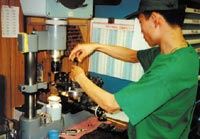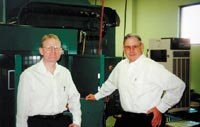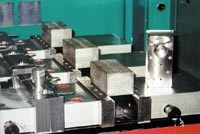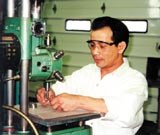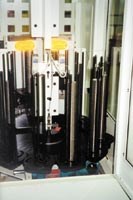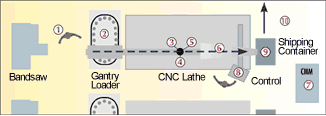For Unattended Machining, Attend To Pre-Process
Efficient use of labor is a primary goal of unattended machining. To successfully reduce process intervention, all of the manufacturing disciplines must participate. Accomplishing this requires detailed pre-process planning, which is the key to optimizing machine, material and manpower resources.
Share





Precision Machinists Company (Chelmsford, Massachusetts) is a 27-year-old production job shop that succeeds by blending technologically current machine tools and intelligent pre-process planning with a workforce engaged in the business of making good parts on time. While that sounds nice in brochure copy, most metalworking professionals realize successfully blending all the manufacturing variables to get parts out the door is not easy.
For most shops, the daily work coordinating material, tooling, scheduling, machine availability and personnel is more like a juggling act. There are many balls in the air at any given time.
But like a juggler on stage, the smooth performance of a shop, as seen by its customers, should be transparent as to the experience and hard work required to make it all look easy. At Precision Machinists Company, the key to making “performance” look easy to the customer is the pre-process planning that goes into each job.
We talked to Jim Smith, president and founder of the company, and Ken Dow, operations manager, about how Precision Machinists Company accomplishes this task. Its automated job shop is a good example of how pre-process planning for unattended machining can make it pay big dividends in terms of throughput, profitability and capacity utilization.
What Is Unattended Machining?
Most metalworking shops would probably agree that unattended machining is more concept than reality. To some extent, it could be argued, application of any machine tool provides some degree of unattended machining.
A milling machine put on automatic feed and a surface grinder with trip dogs on the table travel are examples of unattended machining, albeit for very short time increments. Use of CNC machine tools gives the shop more unattended time because generally a complete part cycle can be run without interruption.
So simply put, a goal of unattended machining is to extend the time increments between operator interventions in the machining process. The advantage of this is less variability in the process. Obviously, to get beyond a single cycle of unattended operation, some amount of automation enters the equation.
The degree of automation in many ways determines how long a given job can run unattended. But, process planning can also impact and extend the unattended time that machines are producing parts. Careful process planning can take unattended machining beyond a single job run to two, three or more jobs processed one after the other with virtually no human intervention.
Got To Have A Plan
From its beginning, Precision Machinists Company has followed a growth curve that is almost a cliché in the metalworking industry. “I started this business in the late 1950s in my basement,” says Mr. Smith. “Slowly, the business grew to the point where I moved from my basement into our present location. That was 1977.”
From the beginning, Mr. Smith realized that automation with a goal of unattended or lightly attended machining was a competitive key, if used right. Initially he was driven to automation because of a lack of skilled people in the New England region. That was in the 1970s, and as most shops realize, it’s a problem today as well.
Once Mr. Smith committed to automation, its use became part of the shop culture, even when the labor market got better. “It made sense to me that if the machine is working, the operator is free to perform other tasks,” he recalls. “I was able to get work done simultaneously rather than in sequence. That is a big advantage in reducing cost and improving delivery.”
As the business grew, Mr. Smith invested early in CNC equipment. “We were considered very advanced for a job shop because of the CNC lathes we installed,” recalls Mr. Smith. “As the technology got better we continued to acquire more automated machines. Along the way we refined our internal process control system to take best advantage of the most current technology. We’ve continued that to this day”
Characteristics Of Unattended Machining
For Precision Machinists Company, the link between being awarded higher volume contracts is the shop’s ability to do lower volume and prototype work. For the shop, prototype work is a prelude to production. It’s the manufacturing method that this shop sells to its customer. Therefore, a process developed for five parts is valid for 5,000 parts.
“We look at our methods as proprietary,” says Mr. Smith. “How we manufacture is our competitive edge, and our methods remain inside our shop. The customer gets the parts they want, but we generally don’t share process details.”
Complexity of the work determines the manufacturing course a job takes through the shop. Precision Machinists has single spindle machining centers, chucker turning centers and levels of automation for each.
“We keep the work moving through the shop,” says Mr. Dow. “A job is run through the shop complete regardless of the number of operations required. That’s a key to keeping lead times down. We maintain a job shop mentality regardless of the quantity of parts on the job.”
On some longer run jobs, blanks are being cut on the saw as finished parts are coming out of the parts washer. It’s a continuous through flow operation that is facilitated by flexible machines, different degrees of automation and tight scheduling.
A key to successful shopfloor production is doing the necessary homework before the job enters production. “Before anything goes out to be manufactured, material is on hand, tooling has been pre-built, setup kits have been assembled and programs written, proved and downloaded,” says Mr. Dow. Two production meetings a week keep all parties appraised of the status of everything in the shop—what’s coming, going and in process.
Precision Machinists Company works in a variety of materials. Stainless and Inconel run through the shop alongside aluminum and steel. Automation does require reduction of variability, especially in the more difficult to machine materials.
“We use the documentation provided by our material supplier to adjust the machining parameters for a given batch of material,” says Mr. Dow. “If, for example, the nickel in a heat of Inconel is slightly high, we know to make feed and speed adjustments to compensate for the difference in machining. It’s part of the pre-process planning. If a job uses more than one heat of material, we plan the sequence of the material so that any chemical differences from between heats that affect machinability can be accommodated through programming.”
Attention to process detail is also found in the shop’s coolant selection. With a variety of materials moving across a given machine, proper coolant selection is a consideration. This shop took the step of having a proprietary formulation developed that has sufficient performance breadth to accommodate the shop’s material mix without the need to change coolant with each job.
“Precision machining does not need to cost more than general machining,” maintains Mr. Smith. “If you have good tools and sound methods, making parts to tolerances of ±0.0001 inch isn’t more expensive than making parts to twice that tolerance.”
Engineering Processes
As a production job shop, Precision Machinists Company sees its value added contribution as process engineering expertise. Making good parts is a byproduct of the shop’s core competency, which is figuring out how to best manufacture the parts. The goal is throughput, quality and cost control. “For one customer,” says Mr. Smith, “we were able to increase production by over 350 percent from their previous process. We know how to get the most from our equipment, and that expertise is what our customers buy from us.”
This expertise plays out on the shop floor in the form of flexible machine tools. In one cell, for example, two Hardinge Conquest Autoloaders run continuously with a gantry loader working from a parts magazine located at the tailstock end of the machine. As many as 1,000 blanks can be queued in this workholder.
In addition to the turning centers, the cell contains a Matsuura twin spindle vertical machining center. All of the VMCs in this shop are equipped with pallet shuttles so spindle utilization is 85 percent, including setup and tear down, which on average is three jobs a day.
One person runs the cell. An example of practical unattended machining is a job that runs across the turning and machining centers and on to a manual deburring operation. One operator is able to run the three CNC machine cell and keep up with the deburring. And it’s not a manic pace to keep it all going.
The Hardinge Autoload turning centers use gang tool bars instead of turrets, which allows the shop to prepare tooling off-line. “As part of the planning process,” says Mr. Dow, “we schedule families of parts or similar parts in sequence to minimize the changeover time. Our gang tool bars often have capacity for three jobs. Setup then only requires reprogramming the gantry and maybe a collet change. It’s fast.”
Likewise, the pallet shuttle feature on the machining centers helps reduce idle time. Multiple workholders are attached to the pallets. These workholders are in general standard vises with machinable jaws. More than one part number can be run across these machines. “They may be making three different parts at one time,” says Mr. Dow.
The shop has standardized its shop on Hardinge turning equipment and Matsuura machining centers. This is by design. “It gives us a continuity,” says Mr. Dow. “Programs are transportable from lathe to lathe and VMC to VMC. Fixturing and tooling are standardized, so we’re free to run work using a variety of routes through the shop.”
Customer Involvement
Precision Machinists Company has around a dozen active customers at any given time. Most of these customers (65 percent and growing), who are primarily in the semi-conductor, medical instrumentation, microwave, aerospace and flow control industries, work with the company under contract.
“Close relations with our customers is a key to our pre process planning,” says Mr. Dow. “We are given the MRP projections for many of our customers, which allow us to see what they anticipate needing in terms of work. It helps us plan material acquisition and schedule the machines with a precision that we couldn’t otherwise achieve. We can, for example, see if a given job quantity is trending up or down and plan accordingly. There are fewer surprises. It also helps us control costs because we can more accurately order raw materials and tooling.”
The shop works on Kan Ban for several customers as well. This system is designed to keep inventory and work in process to a minimum.
At any time, 95 percent of the shop’s inventory is in process. “An example,” says Mr. Dow, “ is one of our customers uses a nine bin Kan Ban system. At any given time, three bins are being manufactured at our shop, three bins are in transit between the customer and us and three bins are on the customer’s line being used. The MRP scheduling we receive from the customer allows us to vary the quantities of the bins to reflect demand. It’s a closed loop system that operates well for both supplier and customer.”
Continuity: From Saws To Shipping
At Precision Machinists, automation where appropriate is the key to better utilize the talents of shop personnel. Rather than think of production as going from job to job, this shop looks at the process as creating a flow of work. “There is continuity from order entry, through pre-process planning to the shipping floor,” says Mr. Dow.
For this shop, automation is not about equipment. It is a business plan. Asset utilization has the goals of reduced human intervention, which reduces variability and allows for better planning. It’s a closed loop.
The process control starts with raw stock and even includes sawing bar stock. In the cut-off operation automatic saws are used, which give the shop 0.005-inch tolerances to reduce variability for the automated part handlers.
Admittedly, the price of automation is higher on the front-end investment, but over the long haul, as this shop illustrates, it pays dividends in throughput and control. “It’s all about planning,” says Mr. Dow. “Automated machines are simply one factor in the equation. If you or your company don’t plan well, forget automation.”
Related Content
6 Machine Shop Essentials to Stay Competitive
If you want to streamline production and be competitive in the industry, you will need far more than a standard three-axis CNC mill or two-axis CNC lathe and a few measuring tools.
Read MoreCNC Machine Shop Honored for Automation, Machine Monitoring
From cobots to machine monitoring, this Top Shop honoree shows that machining technology is about more than the machine tool.
Read MoreWhere Micro-Laser Machining Is the Focus
A company that was once a consulting firm has become a successful micro-laser machine shop producing complex parts and features that most traditional CNC shops cannot machine.
Read MoreHow to Successfully Adopt Five-Axis Machining
While there are many changes to adopt when moving to five-axis, they all compliment the overall goal of better parts through less operations.
Read MoreRead Next
No Experience Necessary
This shop assembled standard machine tools and components into a process for flexible production of a series of complex hydraulic cylinder components - all machined from solid, all accurate in some dimensions to +/-0.025 mm - in quantities that can exceed 3,000 per day, using only two operators per shift to shepherd this production from bar stock to shipping container.
Read MoreRegistration Now Open for the Precision Machining Technology Show (PMTS) 2025
The precision machining industry’s premier event returns to Cleveland, OH, April 1-3.
Read More5 Rules of Thumb for Buying CNC Machine Tools
Use these tips to carefully plan your machine tool purchases and to avoid regretting your decision later.
Read More












